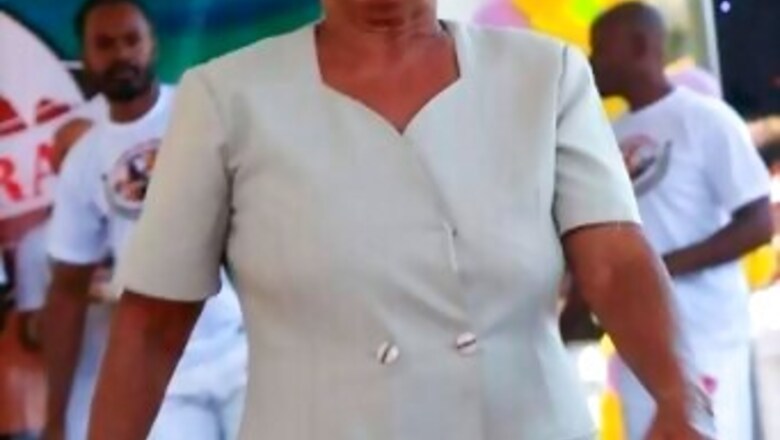
views
ARMAO DE BZIOS, Brazil Carivaldina Oliveira da Costa was the steward of history in her Brazilian community on the northern coast of Rio de Janeiro state, and for two decades fought for their land rights as descendants of escaped slaves.
Known as Dona Uia, she was the matriarch who signed off on all decisions of her community, Rasa, one of Brazils many so-called quilombos. Uia worked tirelessly for the roughly 700 families to be recognized rather than marginalized, according her daughter Nally Oliveira.
I would like to be half the person she was: a good-hearted warrior woman who battled, and always taught us what was right and wrong, said Nally, 41, Uias only daughter.
___
EDITORS NOTE: This is part of an ongoing series of stories remembering people who have died from the coronavirus around the world.
___
Uia was born in Armacao dos Buzios in 1941, when it was just a district of a seaside city discovered by Amerigo Vespucci. It wasnt until the mid-1960s that a visit by French actress Brigitte Bardot bestowed Buzios with celebrity cachet and kicked off its transformation into the elite escape comprised of 23 glistening beaches.
Uias mother had told her stories stories shed heard from her own mother of a bygone era. It was a time when Portuguese ships unloaded enslaved Africans at an outcropping called Father Vitorio Point. They were marched to a hilltop church to be christened, casting off names they received on the opposite side of an ocean, then put to work on sugarcane farms. Still today there are vestiges of slaves quarters.
None of this appears in the history section of Buzios official website.
Buzios only tells about Brigitte Bardot, not its real history, Nally said. Before Brigitte Bardot came to discover the place, there were people here: fishermen and people who didnt even know they were in quilombos, and were descendents of slaves.
Brazil was the last country in the Western Hemisphere to abolish slavery, in 1888. The quilombo communities persisted, though not until a century later did a new constitution for the first time recognize their right to the lands they occupied. Often disconnected from urban life even within city limits, quilombos have relatively high poverty and can be confused by outsiders with other poor neighborhoods. And securing title is a years-long process.
To facilitate government COVID-19 aid, Brazils national statistics and geography agency in April released its estimate of how many quilombos exist nationwide almost 6,000 as well as their locations. The number of people living within them remains uncertain; the agency planned to count them for the first time in the 2020 census, but the pandemic forced its delay until next year. Many, including residents of Rasa, for decades werent certain of their origins.
As a girl, Uias family planted beans, manioc, banana and fruit trees on their land to feed themselves, Nally said. It wasnt enough to survive, however, and at age 13 she set off to Rio de Janeiro, then the nation’s capital. Working as a live-in nanny, Uia sent money home. She was a child helping to raise other children in an apartment visited by politicians of the day.
At 20, Uia returned to Buzios, where she married and for almost four decades helped support eight children working as a maid. She quit not long after founding an association to fight for Rasas traditional rights, sparked by historical research her brother conducted in Portugal.
Uia held meetings and debates, dug up information, traveled across the state for conferences and seminars, and brought her niece, Rejane Oliveira, under her wing in the fight for land. Rejane remembers Uia pacing out the boundaries of Rasa with a representative from the government’s agrarian reform institute, which has been processing the communitys claim for 16 years. Uia’s energy never flagged.
She brought something to Rasa that no politician would bring: self-confidence. Self-confidence came from her, the fight for land, the question of rights, said Rejane, who lives in a nearby quilombo and is Rio states representative in the National Coordination of Black Rural Quilombo Communities.
Uias advanced diabetes was attacking her vision before she contracted the coronavirus. She was admitted to hospital with a symptom believed to be associated with high blood sugar, and died the same day, according to Nally, who contracted the virus herself. Nally says what hurts most is she hadnt an inkling she was about to lose her mother, and didn’t get to say goodbye.
Dona Uia died June 10, at the age of 79. Her death certificate cites COVID-19 as one of the causes.
Buzios mayor decreed three days of official mourning, describing her as a pioneer and a leader in quilombo residents’ fight. However, restrictions on activity due to the pandemic meant it wasnt possible to carry out an official ceremony, City Hall said in an email.
Rasa mourned her passing, and took it as a call to continue her work.
She rescued the history of the ancestors. And today, my mom not being here, theres a loss, understand? Nally said. We have to carry that legacy and pass on to young people what our mother passed to her kids. Tell them about our roots, where our ancestors came from.
______ Biller reported from Rio de Janeiro
Disclaimer: This post has been auto-published from an agency feed without any modifications to the text and has not been reviewed by an editor




















Comments
0 comment